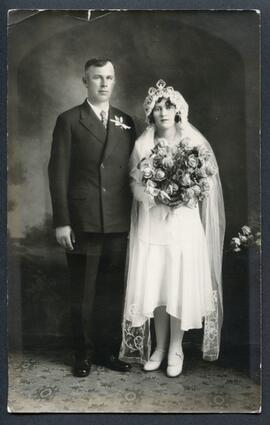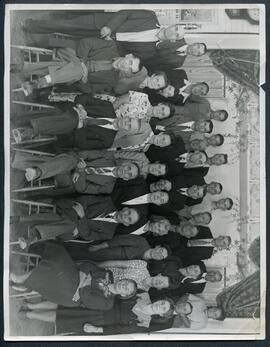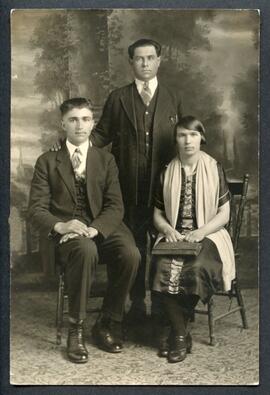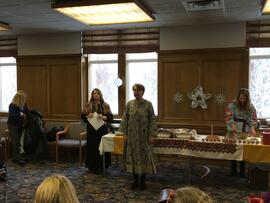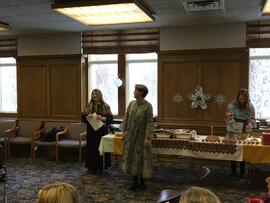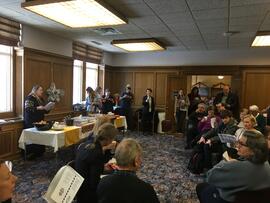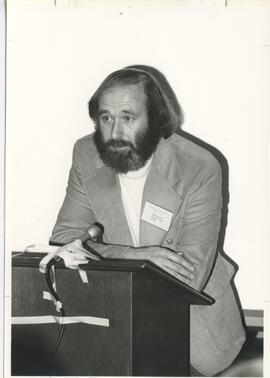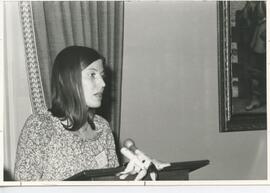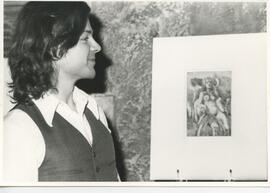Photograph of Annie (Troich) and Alex Paranchych. Photo was taken after they were married in a photo studio where they borrowed the dress and suit for the wedding. Same as 2019.010.021
Photograph of Mr and Mrs Yukobaski who sponsored Fred Paranchych’s mother, Annie Troich, to come to Canada. Mrs Yukobaski is Annie Troich’s cousin.
Photograph of the members of the AUC in Newcastle, AB. Fred Paranchych’s brother Bill is standing centre back row, without a suit jacket. Fred’s father, Alex, is in the 3rd row, 3rd from the left. Fred’s mother is centre 2nd row, partially hidden.
Photograph of relatives of Fred Paranchych, taken in Roznov Ukraine.
Program from Association of Ukrainian Canadians festival in Edmonton. Fred Paranchych attended with his parents and siblings. Fred was 7 years old at the time.
Jelena Pogosjan, Director of the Kule Folklore Centre, is greeting the guests.
Jelena Pogosjan, Director of the Kule Folklore Centre, is greeting the guests.
MLCS Chair Dr. Carry Smith offering her greetings.
This item is an interview conducted on June 15, 1981. Veronica Whitfield interviewed Mr. Herklotz. Mer. Herklotz talks about his family, being in the Soviet Army in WWII, and coming to Canada in 1948 and learning English.
UntitledThis item contains two recordings of interviews conducted in the summer of 1982 in Edmonton, AB. The first interview was conducted in English with Eugene Weber. Mr. Weber was born in Scott, SK in 1932 and the interview discusses the history of his family before and after his birth, and the importance of German community.
The second interview was conducted with Mr. and Mrs. Sommer in Polish, German and English. In the interview, they discuss Mr. Sommer's history of being born in Rivne (Volyn), where his mother also born. His grandfather worked as a basket maker, his father was a farmer in Volyn (Poland). The name of the village was [Maschk]. The father of Mrs. Sommer died after the WW1 and she grew up in another family. In the year 1914, when the WW1 started, Russians took all Germans from Volyn to Siberia. In the year 1916, at the age of 19 he was taken from Siberia to the Russian army. He had to fight at the Russo-Turkish war. In the year 1918, he came from the war to Kostanay after serving in the Russian army. In 1921 he came back to Volyn. His wife and him grew up in the same village and got married in 1923, first lived at her uncle´s place. His older brother lived in Canada and helped his brothers move there too. They came to Canada in June 1929. They came from Maschk to Rivne by train, came to Halifax from Danzig by ship. After they took the train to Edmonton and New Sarepta. After the arrival they stayed at the immigration camp. At the time of immigration they already had three children (born in 1924, 1926 and in 1928). Later they had one more baby (daughter) in Canada.
UntitledThis item contains an interview with Zdzisław Jan Krywkowski, conducted in Stoney Plain, AB on April 19, 1977. The
How did he come to Canada during the war? He came completely legally, from Switzerland where he had been a student. He studied political sciences at the international labor office. Then he came to France, where the so-called 4. Polish division was formed. He never took part in any battle as there were not enough people. He embarked a ship close to Bordeaux in 1940 and arrived in Plymouth. He English were much friendlier than the French from whom the had received no information. As he spoke some English, he went around with a colonel called Koszałkowski Marian. Afterwards, they were brought to Glasgow, then they were living in tents. He spent the whole war in Britain, predominantly in Scotland. He joined the 1. Corps of the Polish Army (the 2. Corps was commanded by General Anders). Among his superiors were General Maćko, his direct superior was Karol Kraćkiewicz (or Kraśkiewicz). In 1944, the worked for the Ministry of Foreign Affairs, on Jewish matters. They countered the propaganda (also in the English press) that all Poles are anti-Semites and that they are persecuting the Jews together with the Germans.
His parents remained in Poland, they spent the war there. He calls Włocławek his native city although he was born in Warsaw, but he spent only four years there. His mother was the headmaster of a large school in Włocławek, a former student of her (an ethnic German) warned her after the German invasion in Poland, and his parents relocated to Warsaw. His father spent a part of the war in Żarnów close to Opoczno, his native village. He recalls a family legend that his ancestors came from Ukraine during one of the Cossack uprisings.
Why did he come to Canada? In Scotland, he worked a teacher but his salary was meagre. He had three specialties: history, political science and economics. When he talks about his experiences as a school teacher, the interviewer asked him to switch to English as it will have to translate the interview. He continues in English: He wanted to work in a secondary school. He received an offer from Alberta. In Ontario, he would have had to study for a year at a university, and BC was slow to answer.
This item contains an interview with a group of interviewees. It is poor sound quality. They discuss Government support to cultural ethnic organizations (?), University of Alberta relation with the community, Multicultural Centre vs Conventional Centre debate(?). The group is discussing the budget and approaching the Government about funds regarding heritage projects(?).
[Ukrainian voice starts from 11:26, sounds of a Jackhammer in the background ]
Various professions the man had to come through
Came to work on a farm. Since 1942 was looking for a job in cities
This item contains a recording of a CEESSA Meeting held on September 14, 1976. Topics covered include:
A meeting regarding the project
The government of Alberta gave money for the project
Aim of part 1 of the project on East European groups – to write a book about historical background of East European immigration; size and distribution of their settlements. The book will be comprised of 10 chapters.
Mrs. Matejko on progress of the work: the work started on October of last year with statistics of all kinds on Central and Eastern European groups. Search in the Provincial Archives. Compiled bibliographies. The most detailed ones are on Poles, Russian Germans, and Jews. Less information on Romanians or people from the Baltic countries.
A need to find private collections of documents and cover 3 waves of immigration. Problems: some communities came in the 1880s, very early, like Russian Germans. Latvian immigrants were very rare, mostly after WWII.
Volunteers are needed to make contacts with old timers and do fieldwork. Germans are the largest community in Alberta coming from Volga region, Black Sea region, and Volyn apart from those from Reich. Mr. Sokolovsky was a research assistant last year and did a great job on Russians, Byelorussians. 2/3 Germans in Alberta are from Central and Eastern Europe.
Problems with counting Czechs and Slovaks because of the former Czechoslovakia. Dr. Horna is working on Slovaks group. Ms. Birzgalis is writing a massive thesis on Latvian community in Alberta (around 1010 people altogether). And Latvian community is very young and predominantly urban comparing to other ethnic groups.
Romanian community research – there is an old settler who was born in Romania. A student in anthropology in Calgary wrote thesis on Polish community – there is interest from outside and people want to help..
A linguist from Poland studies the changes of Polish language in Alberta. He has many interviews with life stories.
High schools now offer a course on ethnic groups in Alberta – they could use a source book from CEESSA.
Discussing that 5 ethnic groups under consideration now but possibly extending the number of ethnic groups for research.
Problems of intermixed settlements of Romanians.
Grant of $10000 for research: $5000 for research associates, $4000 – for field trips, $1000 – for typing.
Mrs. Matejco will be working on all the ethnic communities in addition to the Polish one, and she will get half of that grant money. The University is going to handle the money so that CEESSA will not have to deal with the receipts and report to the Ministry.
Mrs. Matejko used to work on the project for free but put in a lot of time and effort.
Field trips should be longer and more extensive when there is money.
Mrs. Horna will be paid only for her trips and Xeroxing.
People interested in working on 2 different ethnic communities on their own budget (one is a former student working in the Provincial Archives).
To complete the project, trips to the National Archives in Ottawa and archives in Toronto should be made + a trip to the B.C. Archives and Saskatoon – those have unique sources that must be included.
Dr. Rudnytskyi and Dr. [Lupul] were assigned to do a federal project on history of Ukrainians in Canada. The project is far from being completed. CEESSA did not touch the Ukrainian community because they already have the Ukrainian Institute working on it and various funding.
The German community is more difficult than any other one – they are spread all over the province.
Federal government project includes 20 ethnic groups. The only group that was not approached was Slovenes. Dr. Priestley was then asked to do the work on that group. Another group was Finns – someone is researching them now.
The federal government is not going to give money any more for researching ethnic communities because it already did so. But money could be obtained for compiling and publishing memoirs of the pioneers – it could become a bestseller.
Getting money from Canada Council would enable to finish the project without begging from the communities.
This item is a recording of a CEESSA Meeting where the roles and nomination process for the committee was discussed.
This item is a recording of a meeting of CEESSA. Discussions include the question of Hungarian and other courses at the university, the constitution and procedures of the committee, membership dues, and the name of the society.
Department of Education set up a committee on curriculum development but will there be ethnic content or just Canadian? “Units” of studies: “Ethnic mosaic” and “Alberta”. Making sure the ethnic groups get recognition in the history of Western Canada. Working together with Heritage Council History of Western Canada discriminates certain ethnic groups. Some Social Studies programs need to be revised.
Important feature – sizable new groups of immigrants from Eastern Europe. Travel concerns to those countries.
80% of Germans in Alberta are from Eastern Europe. Up to 40% of Alberta population is from Continental Europe

